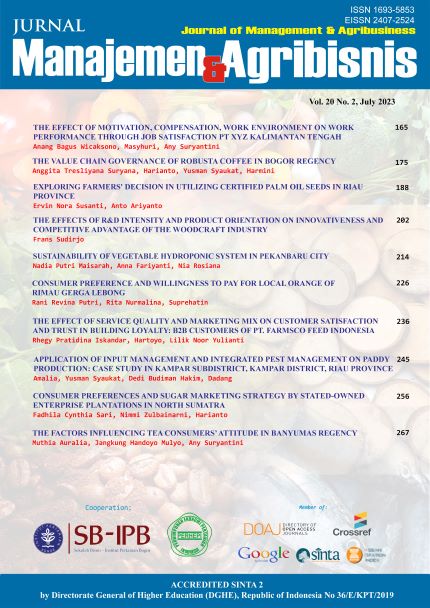Comparative Analysis of Marketing Channels of Cayenne Pepper Through Auction Market and Other Channels in Turi District, Sleman Regency
Abstract
Turi District is one of cayenne pepper production areas in Sleman Regency. The marketing of Cayyene Pepper is interesting to study especially after the chili auction market was established in Sleman Regency in 2018. Therefore, this study aims to compare the marketing of cayenne pepper through the auction market marketing channel with other marketing channels in Sleman Regency based on marketing margin, farmer’s share, and profit ratio to marketing cost. The data collection methods were purposive sampling method applied on farmers and snowball sampling method applied on marketing organization. The results showed that the marketing of cayenne pepper in Turi District, Sleman Regency in 2022 has five marketing channels, namely the auction market, collectors, wholesalers and traders. In addition, the marketing agencies involved have carried out the existing marketing functions, that is the exchange function, physical function and facility function. Basically, channel III through large traders has a quantitative indicator value of marketing efficiency that is better than channel I. Meanwhile, for local market destinations channel II has a better efficiency indicator value than channel IV which goes through small collectors.
Keywords: auction market, cayenne pepper, marketing channels, marketing efficiency, marketing functions
Authors
Authors who publish with this journal agree to the following terms:
- Authors retain copyright and grant the journal right of first publication with the work simultaneously licensed under a Creative Commons Attribution License that allows others to share the work with an acknowledgement of the work's authorship and initial publication in this journal.
- Authors are able to enter into separate, additional contractual arrangements for the non-exclusive distribution of the journal's published version of the work (e.g., post it to an institutional repository or publish it in a book), with an acknowledgement of its initial publication in this journal.
- Authors are permitted and encouraged to post their work online (e.g., in institutional repositories or on their website) prior to and during the submission process, as it can lead to productive exchanges, as well as earlier and greater citation of published work (See The Effect of Open Access).

